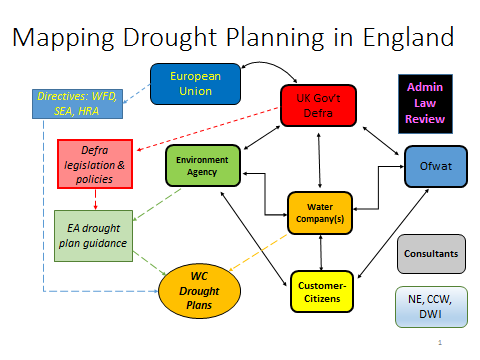Key science findings
Relationships of power between key institutional actors involved in managing drought are central to understanding how regulatory tools are used.
Key current, on-going reforms of the regulatory framework, such as abstraction reform, are likely to have localized and abstractor specific impacts.
We see different types of environmental science knowledges used to different degrees for the use of regulatory tools for managing drought. A clear gap seems to be a lack of knowledge about the impact of drought on land and water based ecological systems.

This figure maps the drought planning framework in England. The key actors in the governance space for drought planning in England are Defra, Ofwat, the EA, water companies, customer-citizens, and consultants. Other actors include Natural England (NE), the Consumer Council for Water (CCW) the Drinking Water Inspectorate (DWI), and the European Union (EU). In this figure, actors are represented by round-cornered rectangles. Square-cornered rectangles represent legal and policy institutions and the oval represents documents, in this case drought plans, produced by water companies as mandated by legislation and pursuant to soft law guidance. The solid black two-way arrows between the actors represent relationships between actors and indicate a flow of information between them. The dotted arrows between actors and legal and policy institutions indicate which actors lead the development of particular legal or policy institutions. The dotted arrows between the legal and policy institutions suggest a relationship between them. For example, the EA drought plan guidance is derived from the Defra legislation and policies and, in turn, the EA guidance provides a structure to the mandatory drought plans. The black box represents administrative law review processes which can overturn decisions made by government ministries and agencies. Water companies are at the centre of our map of the English governance regime for drought because they are the main abstractor of water from the natural environment in the UK. Hence, any effective drought management options must enlist water companies in strategies for efficient use of water.
Further information
Lange, Bettina, and Christina Cook. “Mapping a Developing Governance Space: Managing Drought in the UK.” Current Legal Problems (2015): cuv014.




